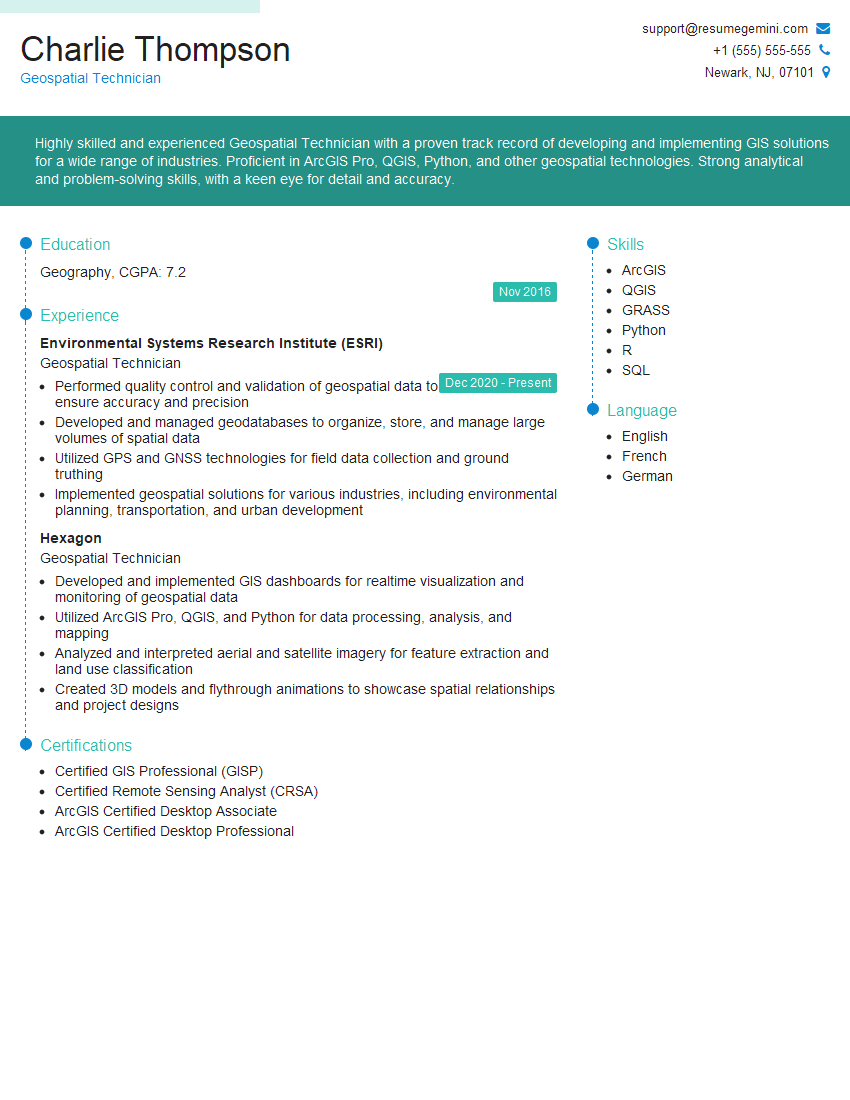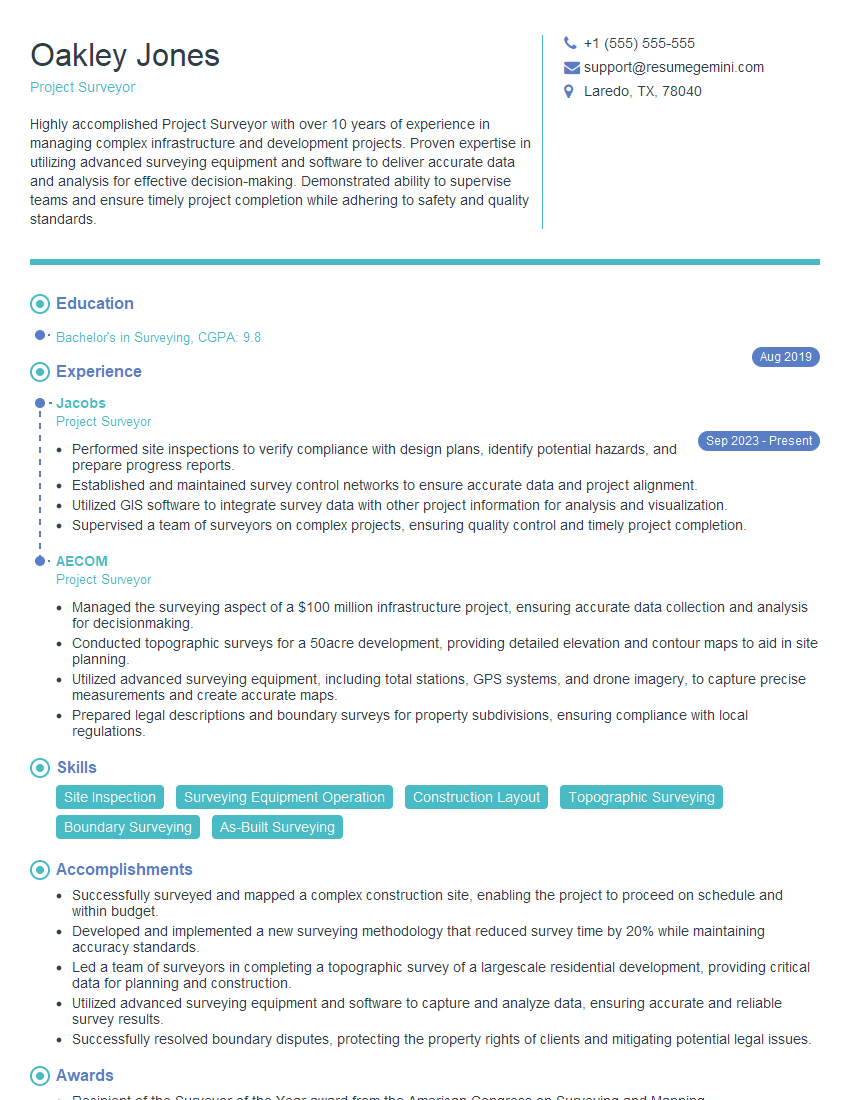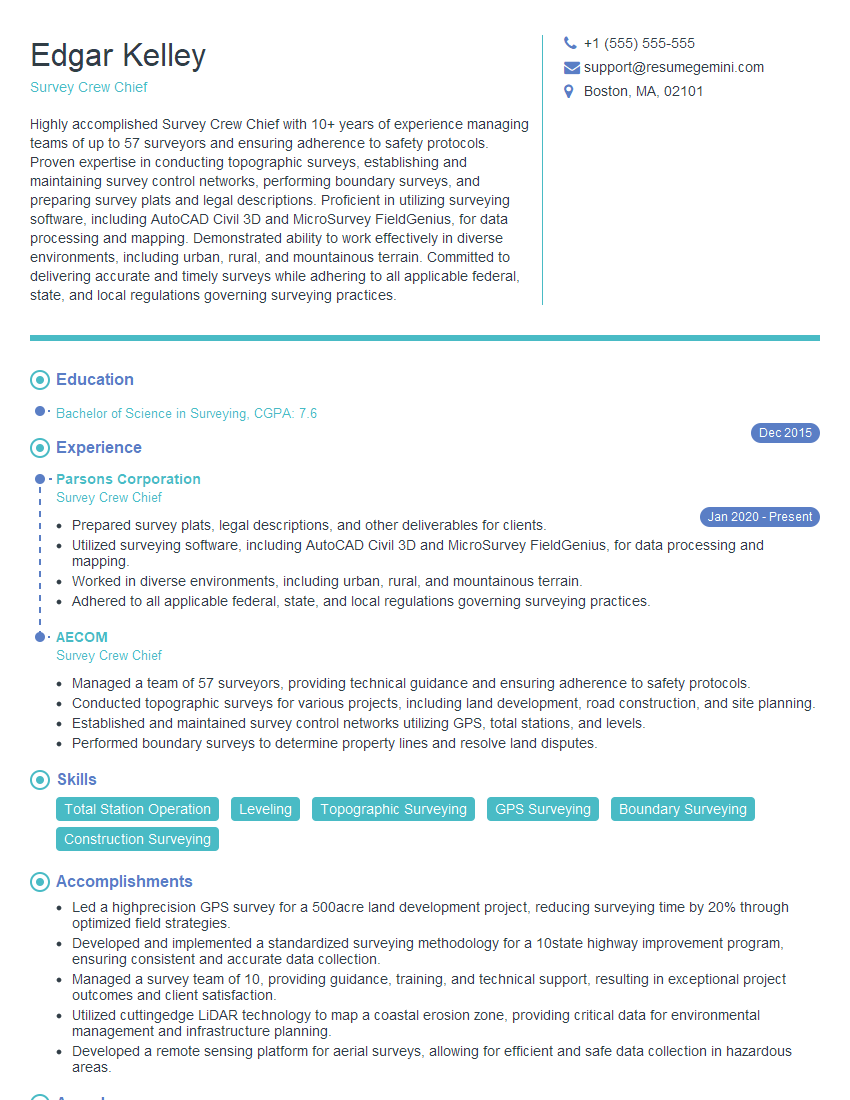Unlock your full potential by mastering the most common Kinematic GNSS Surveying interview questions. This blog offers a deep dive into the critical topics, ensuring you’re not only prepared to answer but to excel. With these insights, you’ll approach your interview with clarity and confidence.
Questions Asked in Kinematic GNSS Surveying Interview
Q 1. Explain the difference between static and kinematic GNSS surveying.
Static and kinematic GNSS surveying are two distinct approaches to using Global Navigation Satellite Systems (GNSS) for precise positioning. The key difference lies in how the receiver antennas are positioned and how data is processed.
Static surveying involves setting up GNSS receivers at fixed points for an extended period, typically several hours or even longer. During this time, the receivers continuously record satellite signals. The long observation time allows for the accumulation of many measurements, improving the accuracy of position determination. This method excels in high-accuracy base mapping and control network establishment. Think of it like carefully taking multiple, precise measurements to achieve a very accurate final result.
Kinematic surveying, on the other hand, uses a roving receiver that moves continuously while recording satellite signals. The position of the roving receiver is determined relative to a base station, a receiver placed at a known location. This method is much faster than static surveying, as it doesn’t require long observation times at each point. Kinematic surveying is ideal for tasks such as mapping roads, pipelines, or other linear features. Imagine it as a quick and efficient survey technique that follows a path.
Q 2. Describe the principles of RTK (Real-Time Kinematic) GPS.
Real-Time Kinematic (RTK) GPS is a precise positioning technique that uses two GNSS receivers: a base station at a known location and a rover receiver in motion. The core principle is the differential correction of the raw carrier phase measurements from the rover. The base station continuously tracks the satellites and calculates its precise position using various advanced techniques. These precise position values, along with information about satellite geometry, atmospheric conditions, and other errors, are transmitted to the rover in real-time through a communication link (often radio).
The rover receiver uses these corrections to eliminate the majority of errors present in its own raw measurements. The result is centimeter-level accuracy in real time. This is unlike standard GPS, which can be off by several meters, simply because the system doesn’t continuously account for atmospheric delays and other systemic errors that are compensated in RTK.
Q 3. What are the common error sources in Kinematic GNSS surveying, and how are they mitigated?
Kinematic GNSS surveying is susceptible to various error sources. Understanding and mitigating these is crucial for achieving high accuracy. Common error sources include:
- Atmospheric effects: Ionospheric and tropospheric delays affect the signal travel time and can be significant sources of error, but differential techniques and atmospheric models significantly reduce their impact.
- Multipath effects: Signals bouncing off buildings or other surfaces before reaching the receiver can cause errors, often addressed by antenna design and signal processing techniques.
- Satellite geometry: Poor satellite geometry (low PDOP – Position Dilution of Precision) can weaken position estimates. Planning survey times to maximize satellite visibility helps.
- Receiver noise: Electronic noise within the receiver can introduce errors; high-quality receivers with good noise characteristics help minimize this.
- Cycle slips: Interruptions in the continuous phase tracking of a satellite signal due to obstructions or weak signals. Cycle slips can cause large position jumps and are dealt with through cycle slip detection and correction algorithms.
Mitigation strategies involve using techniques like RTK, precise point positioning (PPP), applying atmospheric models, careful antenna placement to reduce multipath effects, utilizing high-quality receivers, and implementing rigorous data processing procedures including quality control checks and outlier detection.
Q 4. Explain the role of base station in RTK GNSS surveying.
In RTK GNSS surveying, the base station plays a vital role. It’s a fixed receiver positioned at a known, highly accurate location, often determined using precise techniques like static surveying. The base station continuously monitors the satellites and generates highly precise positional data. This data, including corrections for atmospheric and other errors affecting the satellite signals, is then transmitted to the rover receiver via a radio link.
The base station’s role is to act as a reference point, essentially providing the rover with the information it needs to accurately correct its own measurements. Without a reliable and accurately positioned base station, the accuracy of the rover’s position determination is significantly compromised. Imagine a ship needing a lighthouse for precise navigation – the base station performs that function in RTK GNSS.
Q 5. What are the different types of GNSS constellations (e.g., GPS, GLONASS, Galileo) and their advantages?
Several GNSS constellations are available globally, each offering unique advantages:
- GPS (USA): The most widely used constellation, providing good global coverage. Its well-established infrastructure and mature technology contribute to its reliability.
- GLONASS (Russia): Offers global coverage and is a good alternative or supplement to GPS. Its constellation geometry can sometimes be more favorable than GPS, improving accuracy in specific areas.
- Galileo (EU): A relatively newer constellation offering high accuracy, high integrity signals, and improved performance in challenging environments. Its focus on civilian use and open-access signals sets it apart.
- BeiDou (China): Another global navigation satellite system providing comprehensive coverage, particularly strong in the Asia-Pacific region.
Using multiple constellations (multi-GNSS) in a survey improves the accuracy and reliability of positioning solutions by providing more observations and mitigating the impact of potential satellite outages or signal degradation.
Q 6. How does atmospheric refraction affect GNSS measurements?
Atmospheric refraction is a major source of error in GNSS measurements. It’s caused by variations in the refractive index of the atmosphere due to changes in temperature, pressure, and humidity. As GNSS signals travel through the atmosphere, their paths bend, causing a delay. This delay affects the time it takes for the signal to reach the receiver, resulting in errors in the calculated range and ultimately, the position.
The impact of atmospheric refraction is particularly significant for signals passing through the troposphere (lower atmosphere) and the ionosphere (upper atmosphere). Tropospheric delays are relatively constant, while ionospheric delays can be highly variable and more challenging to correct. Advanced models and correction techniques, often incorporated into RTK and PPP processing, are used to minimize the effects of atmospheric refraction on GNSS measurements.
Q 7. Explain the concept of Differential GNSS (DGPS).
Differential GNSS (DGPS) is a technique used to improve the accuracy of GNSS positioning by correcting for systematic errors present in the raw measurements. It utilizes a base station at a known location that continuously monitors the same satellites as the rover receiver.
The base station calculates its own position using the raw satellite signals. The difference between the calculated position and the known, precise position represents the error affecting the satellite signals at that time. These errors, including those caused by atmospheric delays and satellite clock errors, are then broadcast to the rover receiver. The rover applies these corrections to its raw measurements, substantially improving accuracy from meters to potentially sub-meter level, although not to the same degree of precision as RTK. DGPS is a more cost-effective and simpler solution when centimeter accuracy isn’t necessary.
Q 8. Describe the process of post-processing kinematic GNSS data.
Post-processing kinematic (PPK) GNSS data involves combining data from a rover receiver and a base station receiver after the survey is completed. Think of it like this: the base station acts as a known, fixed point, and the rover’s position is calculated relative to it. This differs from real-time kinematic (RTK) where positions are determined on the fly.
The process typically involves these steps:
- Data Collection: Simultaneous data logging from both rover and base station receivers. This often requires highly accurate, high-rate data logging (e.g., 1 Hz or higher).
- Data Pre-processing: This step involves checking for any obvious errors in the data, such as outliers or significant gaps. We might also perform cycle slip detection and correction at this stage.
- Base Station Processing: Precise coordinates for the base station are determined using high-precision reference data, such as from a continuously operating reference station (CORS) network. This provides a highly accurate reference point for all subsequent calculations.
- Double-Differencing: This is a crucial step that eliminates many error sources, including atmospheric delays and satellite clock errors. It involves differencing the observations from the rover and base station, then differencing these differences again for different satellites. This significantly improves accuracy.
- Coordinate Transformation: The final coordinates of the rover are usually transformed into a desired coordinate system (e.g., UTM, State Plane) using appropriate parameters like geoid models and datum transformations.
- Quality Control: Finally, a thorough quality control check is performed, examining various statistical measures to assess the accuracy and reliability of the results. This often involves analyzing residuals and assessing the overall precision.
The result is a set of highly accurate coordinates for the points surveyed by the rover.
Q 9. What software packages are you familiar with for processing GNSS data?
I’m proficient in several software packages for processing GNSS data. These include:
- RTKLIB: An open-source, versatile software package that allows for both RTK and PPK processing. Its flexibility is a great strength, allowing for customization and advanced processing options.
- Teledyne Optech’s MAGNET Office: A comprehensive software suite for surveying data processing, including GNSS data from various manufacturers. It offers a user-friendly interface with powerful post-processing capabilities.
- Trimble Business Center (TBC): This is a commercial software solution widely used in the industry, known for its robust processing capabilities and integration with Trimble equipment.
- Leica Geo Office: Similar to TBC, this software integrates well with Leica equipment and provides comprehensive tools for processing and analyzing GNSS data.
My experience spans various platforms, allowing me to adapt to diverse project requirements and data formats.
Q 10. How do you ensure the accuracy and reliability of your GNSS measurements?
Ensuring the accuracy and reliability of GNSS measurements is paramount. I use a multi-faceted approach:
- Careful Equipment Selection: Employing high-precision GNSS receivers with appropriate multi-frequency capabilities (e.g., capable of using L1 and L2 or L1, L2, and L5 frequencies). This helps mitigate atmospheric effects.
- Optimal Antenna Setup: Proper antenna placement, ensuring clear sky visibility and minimal multipath effects, is crucial. This often involves selecting an appropriate antenna height and avoiding obstructions.
- Precise Base Station Selection: Using a stable and accurately known base station, ideally connected to a CORS network for the highest precision. The closer the base station is to the rover, the better the accuracy.
- Rigorous Data Processing: Employing appropriate post-processing techniques like double-differencing, and applying appropriate atmospheric models and corrections. The use of quality software and thorough QC is critical.
- Redundancy Checks: Repeating measurements, performing multiple sessions, or using multiple receivers can provide independent checks and improve confidence in the results. This is especially important in challenging environments.
- Environmental Considerations: Accounting for factors like atmospheric conditions, multipath, and antenna phase center variations, which can significantly affect measurements. This can involve specialized data processing techniques or environmental correction models.
By combining these strategies, I ensure the highest level of confidence in my GNSS measurements.
Q 11. Explain the importance of proper antenna setup and calibration in GNSS surveying.
Proper antenna setup and calibration are fundamental to accurate GNSS surveying. Imagine trying to measure distance with a crooked ruler – you’ll get inaccurate results. Similarly, improperly set up antennae will lead to flawed measurements.
Antenna Setup:
- Clear Sky View: The antenna needs a clear view of the sky, free from obstructions like trees, buildings, or even dense foliage. Obstructions can block signals and lead to multipath errors.
- Antenna Height and Stability: The antenna must be securely mounted at a known height, ideally using a stable tripod. Any movement during measurement will affect accuracy.
- Phase Center Variation: Antennas have a phase center, which is the point from which the signals appear to originate. This point can shift slightly depending on the satellite geometry and frequency. This needs to be considered during calibration and processing.
Antenna Calibration:
- Regular Calibration: Regular calibration ensures that the antenna is performing optimally. This can involve comparing measurements against a known reference point or sending the antenna to a specialized calibration laboratory.
- Phase Center Offset: The calibration process may determine the antenna’s phase center offset, accounting for any deviation from the ideal point, improving the accuracy of the final coordinates.
Proper antenna setup and calibration are not just good practice, they’re essential for obtaining reliable and accurate GNSS measurements.
Q 12. What are the limitations of GNSS surveying?
While GNSS surveying is incredibly powerful, it has limitations:
- Signal Obstructions: Buildings, trees, and other obstacles can block GNSS signals, leading to inaccurate or unavailable measurements. Dense urban canyons are a particular challenge.
- Multipath Effects: Signals reflecting off surfaces can interfere with the direct signal, leading to errors in positioning. This is especially problematic in urban areas.
- Atmospheric Effects: The ionosphere and troposphere can delay GNSS signals, causing errors in positioning. While corrections are available, they are not perfect.
- Satellite Geometry: The accuracy of GNSS measurements is also affected by the geometry of the satellites in the sky. Poor geometry can lead to weaker solutions and lower accuracy.
- Receiver Limitations: The quality and capabilities of the GNSS receivers themselves can impact the accuracy and reliability of measurements. Older receivers or those with lower specification can lead to reduced precision.
- Cycle Slips: Loss of lock on the satellite signal can cause significant jumps in the recorded data, affecting positional accuracy. These require careful detection and mitigation.
Understanding these limitations is crucial for successful GNSS surveying. Careful planning, proper equipment selection, and robust data processing are key to minimizing these effects.
Q 13. How do you deal with multipath effects in GNSS measurements?
Multipath errors, caused by reflected GNSS signals, are a common problem. Imagine trying to hear someone speak clearly in a large, echoing room. The reflected sound waves make it difficult to understand. Multipath is similar; reflected signals confuse the receiver.
Mitigation strategies include:
- Careful Antenna Placement: Positioning the antenna in a location with minimal reflections is crucial. This often involves finding an open area away from reflective surfaces.
- Antenna Type: Using antennas specifically designed to minimize multipath effects, such as choke-ring antennas, can help.
- Data Processing Techniques: Advanced data processing techniques can help identify and filter out multipath signals. This often involves analyzing the signal characteristics and identifying inconsistencies. Some algorithms use signal strength and arrival times to mitigate the effect of reflected signals.
- High-Elevation Satellites: Prioritizing measurements from satellites at higher elevation angles can reduce multipath effects because the signal path is less likely to encounter reflective surfaces.
A combination of these techniques significantly reduces the impact of multipath errors on the overall accuracy.
Q 14. Explain the concept of cycle slips and how they are detected and corrected.
A cycle slip is a sudden loss and reacquisition of lock on a satellite signal. Think of it like a skipping CD – the music (GNSS signal) suddenly jumps, causing a discontinuity in the data. This results in a jump in the measured phase, leading to errors in position.
Detection: Cycle slips are typically detected by analyzing the change in the carrier phase measurements over time. A sudden, large jump in the phase is a clear indicator. Software packages often automatically detect cycle slips, using algorithms to compare consecutive phase measurements and identify anomalies.
Correction: Correcting cycle slips involves recovering the lost cycles. This usually involves using information from other satellites or from the code measurements to estimate the amount of phase slippage. Advanced techniques, such as using multiple frequencies, can improve the reliability of cycle slip repair. If correction is impossible, the affected data epochs may need to be removed from the solution.
Failure to detect and correct cycle slips can result in significant errors, rendering the GNSS measurements unusable. Therefore, careful monitoring and appropriate processing are essential.
Q 15. What are the different types of GNSS receivers and their applications?
GNSS receivers come in various types, each suited for specific applications. The key distinctions lie in their capabilities, cost, and size.
- Single-frequency receivers: These are generally more affordable and suitable for less demanding applications like basic navigation or less precise surveying. They track signals from only one frequency band (typically L1). Accuracy is limited compared to dual-frequency receivers. Think of them as a basic compass, providing general direction but not the exact coordinates.
- Dual-frequency receivers: These receivers track signals from two frequencies (L1 and L2). This significantly improves accuracy by mitigating the effects of atmospheric delays (ionospheric and tropospheric). They are commonly used in high-precision surveying and mapping projects where centimeter-level accuracy is needed. They are like a high-precision theodolite, capable of extremely accurate measurements.
- Multi-frequency receivers: These advanced receivers can track signals from multiple frequencies (e.g., L1, L2, L5). This further enhances accuracy and allows for better signal tracking in challenging environments with multipath interference. They are commonly found in high-precision applications such as precise point positioning (PPP) and real-time kinematic (RTK) surveying.
- Geodetic-grade receivers: These receivers are designed for the highest accuracy and stability. They typically incorporate features such as advanced signal processing techniques, multiple antennas, and robust data logging capabilities. These are used in very high-precision applications, such as monitoring tectonic plate movement or creating highly accurate base maps.
The choice of receiver depends heavily on the project requirements. For instance, a simple land boundary survey might only require a single-frequency receiver, while a deformation monitoring project would demand a geodetic-grade receiver with high-sampling rates.
Career Expert Tips:
- Ace those interviews! Prepare effectively by reviewing the Top 50 Most Common Interview Questions on ResumeGemini.
- Navigate your job search with confidence! Explore a wide range of Career Tips on ResumeGemini. Learn about common challenges and recommendations to overcome them.
- Craft the perfect resume! Master the Art of Resume Writing with ResumeGemini’s guide. Showcase your unique qualifications and achievements effectively.
- Don’t miss out on holiday savings! Build your dream resume with ResumeGemini’s ATS optimized templates.
Q 16. Describe your experience with different types of GNSS antennas.
My experience encompasses various GNSS antenna types, each with its unique characteristics and applications. The selection of an antenna depends on factors like the desired accuracy, environmental conditions, and the type of surveying application.
- Choke Ring Antennas: These are commonly used for their excellent multipath rejection capabilities. They are ideal for urban environments or areas with significant reflections where multipath is a significant source of error. I’ve used these extensively in dense urban areas for RTK surveys.
- Patch Antennas: These are low-profile antennas suitable for applications where size and weight are critical. They are often used in handheld receivers or UAV-based surveying. However, their multipath rejection is typically not as good as choke ring antennas.
- Geodetic Antennas: These are high-precision antennas designed for centimeter-level accuracy and stability. They are often used in base stations or for high-accuracy static surveying. I’ve relied on these for projects needing exceptional accuracy, such as precise deformation monitoring.
- GPS/GLONASS/Galileo/BeiDou antennas: Modern antennas are often designed to track signals from multiple GNSS constellations, which increases the number of satellites tracked and improves overall solution reliability and precision. This is crucial for overcoming issues like satellite geometry.
Antenna phase center variation (PCV) is a crucial factor. Proper calibration and modeling of PCV is essential for achieving high accuracy. I’ve utilized various techniques for PCV compensation, such as using manufacturer-supplied data or conducting independent calibrations.
Q 17. How do you handle data inconsistencies or outliers during post-processing?
Handling data inconsistencies and outliers is crucial for ensuring the integrity of GNSS survey results. My approach involves a multi-step process:
- Data Inspection: I start by visually inspecting the data using GNSS processing software. This involves checking for obvious outliers, jumps in the data, or unrealistic coordinate changes. Think of it like reviewing a photograph – you would instantly notice something out of place.
- Statistical Analysis: I use statistical methods to identify outliers. This might involve calculating the standard deviation and removing data points falling outside a certain threshold (e.g., 3 sigma). We’re trying to identify data that is statistically unlikely to be accurate.
- Cycle-Slip Detection and Repair: Cycle slips, which represent sudden jumps in the carrier phase, can significantly affect the accuracy. I utilize algorithms to detect and repair cycle slips. These algorithms examine the data for sudden discontinuities and then ‘fix’ the data by using smoothing and interpolation techniques.
- Outlier Rejection Techniques: I employ robust estimation techniques, such as least-squares adjustments with robust weights or outlier removal methods, to minimize the impact of outliers on the final solution. These methods downplay the influence of outliers and focus on more reliable data points.
- Detailed investigation: If outliers are persistently present despite these steps, further investigation might be necessary. This could involve examining environmental factors, receiver issues, or satellite geometry issues which might have affected the observations. Think of this as the ‘forensic’ part of data analysis.
A combination of automated algorithms and visual inspection is essential for a thorough and effective quality control process. It’s like a detective investigating a crime scene – you need both scientific methods and careful observation to get to the truth.
Q 18. Explain the coordinate systems used in GNSS surveying.
GNSS surveying utilizes various coordinate systems, each with specific reference frames and datums. The choice depends on the project’s geographic location and accuracy requirements.
- Geographic Coordinate System (GCS): This system uses latitude, longitude, and height to define a point’s location on the Earth’s surface. Latitude and longitude are angles relative to the Earth’s ellipsoid, and height might be an ellipsoidal height or orthometric height (above mean sea level). This system is commonly used for global positioning.
- Projected Coordinate System (PCS): This system projects the Earth’s curved surface onto a flat plane, which simplifies calculations and area measurements. Many different projections exist, each with its own properties and distortions. The choice of projection depends on the area being surveyed and the type of map being created. Think of it as flattening a piece of orange peel, which inevitably causes some distortions.
- Local Coordinate Systems: These are typically used for smaller-scale surveys, referencing a local datum. These are often Cartesian systems (x, y, z), that might reference a specific known point within the survey area. This system is useful for simplifying local surveying tasks.
- Reference Frames: The reference frame defines the orientation and origin of the coordinate system. Examples include ITRF (International Terrestrial Reference Frame) which is a global, Earth-fixed frame, and local frames which are specific to a certain region. Choosing the correct reference frame is essential for ensuring data consistency and accuracy across different surveys.
Understanding these systems and their relationships is fundamental to ensure accuracy and consistency across projects. Incorrect coordinate system choice can lead to significant errors in location and distance measurements.
Q 19. What is the significance of datum transformations in GNSS surveying?
Datum transformations are crucial in GNSS surveying because different coordinate systems (and datums) use different models of the Earth’s shape and orientation. This means that coordinates measured in one datum will not directly match coordinates in another.
Datum transformations involve converting coordinates from one datum to another to ensure compatibility and consistency. This process often involves complex mathematical models that take into account the differences in the underlying ellipsoids, geodetic parameters, and reference frames.
For example, converting coordinates from NAD83 (North American Datum of 1983) to WGS84 (World Geodetic System 1984) is a common transformation needed when integrating data from various sources. Without accurate transformation, significant errors could result in integrating data from different surveys.
Common transformation methods include Helmert transformations (7 parameter) which involve translation, rotation, and scaling, and more sophisticated methods which might include higher-order polynomial transformations. These techniques require parameters specific to the datums involved. These parameters are usually publicly available or can be derived based on common control points where the coordinates in different datums are known.
Neglecting datum transformations can result in significant positional errors, rendering the survey data unreliable. Accurate datum transformations are essential for seamless integration of data from different sources and ensure the overall consistency and accuracy of the project.
Q 20. Describe your experience with quality control and quality assurance procedures in GNSS surveying.
Quality control (QC) and quality assurance (QA) are fundamental aspects of my GNSS surveying workflow. I follow a rigorous protocol throughout the entire process, from planning to final report generation.
- Pre-survey planning: This includes careful site selection, considering factors like satellite visibility, multipath, and environmental conditions. Detailed planning minimizes errors early on and improves data quality.
- Equipment calibration and maintenance: I regularly calibrate my GNSS receivers and antennas, ensuring their proper functioning. Properly maintained equipment ensures data consistency and minimizes errors.
- Real-time monitoring: During data acquisition, I constantly monitor the data quality, checking for cycle slips, low signal strength, and other anomalies. This allows for immediate correction of potential issues.
- Post-processing QC: After data acquisition, I meticulously review the processed data. This involves checking the precision of the measurements, identifying and handling outliers, and checking for systematic errors.
- Independent checks: I independently validate the results using different processing software or by comparing with other data sources such as topographical maps or existing surveys. Multiple independent assessments highlight any potential systematic errors.
- Documentation: I maintain detailed records of all aspects of the survey process, including equipment, settings, observations, and processing steps. Meticulous documentation ensures transparency and accountability.
My commitment to QA/QC ensures the highest level of accuracy and reliability in the final deliverables. This comprehensive approach reduces potential errors and maximizes the value of the produced data.
Q 21. How do you ensure the integrity of GNSS data throughout the entire workflow?
Maintaining the integrity of GNSS data throughout the workflow is paramount. This requires a combination of careful planning, rigorous data handling practices, and robust quality control procedures.
- Data Acquisition: Ensuring proper receiver settings, optimal antenna placement, and continuous monitoring during data collection are critical first steps. This stage sets the foundation for high-quality data.
- Data Storage and Transfer: Data should be stored securely and transferred using reliable methods to prevent corruption or loss. I typically use redundant data storage and utilize secure transfer protocols.
- Data Processing: Rigorous post-processing procedures, including cycle-slip detection and correction, outlier removal, and appropriate datum transformations, are crucial. This stage ensures the consistency and accuracy of the results.
- Quality Control: Independent verification of the results through statistical analysis and comparison with other data sources strengthens the integrity of the data. The QC stage validates the accuracy of the entire process.
- Documentation: Maintaining complete records of all stages of the process, including hardware, software, and processing parameters, allows for traceability and reproducibility, enabling future verification.
- Error Propagation Analysis: Assessing the uncertainties and potential error sources throughout the workflow helps to quantify the reliability of the final results. Understanding error propagation allows for informed decision making and reporting of uncertainties.
A well-defined workflow, combined with a commitment to rigorous quality control, is essential to produce reliable and trustworthy GNSS survey data. It’s like building a house – a strong foundation (data acquisition) and careful construction (processing and QC) are crucial to ensure the final structure (results) is stable and reliable.
Q 22. What are the applications of Kinematic GNSS surveying in your field?
Kinematic GNSS surveying, using techniques like Real-Time Kinematic (RTK) and Post-Processed Kinematic (PPK), offers a wide array of applications in my field. It’s the backbone of high-accuracy positioning for various tasks. Think of it as giving a GPS a significant accuracy boost.
- High-Precision Mapping: Creating detailed maps for construction, infrastructure development, and environmental monitoring. For example, accurately mapping the as-built condition of a bridge after construction to verify design specifications.
- Precise Surveying and Engineering: Defining boundaries, setting out points for construction, and monitoring deformation in structures like buildings or dams. We might use it to precisely locate underground utilities before excavation.
- Asset Management: Accurately positioning and tracking assets such as pipelines, power lines, or even individual trees in a forest for inventory and maintenance. Imagine tracking the precise location of each wind turbine in a wind farm.
- Precision Agriculture: Guiding machinery for optimized planting, spraying, and harvesting, resulting in improved yields and reduced resource use. This includes applying variable-rate fertilizer based on precise location data.
- Mobile Mapping: Collecting highly accurate geospatial data while moving, such as capturing 3D models of roads or urban environments for autonomous vehicle development or updating digital twins of cities.
Q 23. Explain your experience with different data formats used in GNSS surveying.
My experience encompasses a range of GNSS data formats, each with its strengths and weaknesses. Understanding these formats is crucial for efficient data processing and analysis.
- RINEX (Receiver Independent Exchange Format): This is the industry standard for exchanging raw GNSS observation data. It’s a text-based format, making it easily readable and portable across different software packages. I frequently work with RINEX files for both RTK and PPK processing.
- CMR (Compact Measurement Record): A more compact binary format that reduces file size compared to RINEX, useful when dealing with large datasets. It’s often used for efficient storage and transfer of data, especially in mobile mapping applications.
- Proprietary Formats: Many GNSS receiver manufacturers use their own proprietary data formats, often requiring specialized software for processing. While convenient for their specific receivers, interoperability can be a concern.
- Database Formats: Processed GNSS data is often stored in database formats such as Geodatabases (ESRI), or spatial databases like PostGIS, for efficient spatial querying and analysis. Integrating with GIS software is vital in our work.
My proficiency spans these formats, ensuring seamless data flow throughout the surveying workflow.
Q 24. How do you use GNSS data for integration with other geospatial data?
GNSS data acts as a powerful spatial foundation for integrating with other geospatial data sources. This integration is essential for building complete and context-rich datasets.
For instance, we might integrate high-accuracy GNSS coordinates with:
- Aerial Imagery: Geo-referencing aerial photographs or orthomosaics, allowing for precise measurements and feature extraction from the imagery. This enables us to leverage both the precise location and visual details from the photos.
- LiDAR Data: Combining GNSS data with LiDAR point clouds to create 3D models with accurate spatial positioning, valuable for topographic surveys or generating digital terrain models.
- Cadastral Data: Integrating GNSS data with land parcel boundaries to accurately determine property lines and identify encroachments. This requires very precise coordinate systems.
- Attribute Data: Joining GNSS coordinates with descriptive information (e.g., soil type, tree species, building materials) to create feature-rich geospatial databases. This adds context to the raw point locations, enhancing the value of the data.
This integration typically involves using Geographic Information Systems (GIS) software, and requires a good understanding of coordinate systems and projections to ensure consistency and accuracy.
Q 25. Describe your understanding of error propagation in GNSS measurements.
Understanding error propagation in GNSS measurements is crucial for ensuring the accuracy and reliability of our surveys. Multiple error sources contribute to the overall uncertainty in GNSS positioning.
- Atmospheric Effects: Ionospheric and tropospheric delays affect signal travel time, leading to position errors. Precise models and correction techniques, such as precise point positioning (PPP), are used to mitigate these effects.
- Satellite Geometry: The relative positions of the satellites affect the accuracy of the solution. A poor geometry (low PDOP – Position Dilution of Precision) leads to amplified errors. Selecting favorable satellite constellations improves this.
- Multipath Errors: Signals reflecting off surfaces can introduce errors. Careful antenna placement and signal processing techniques help minimize multipath.
- Receiver Noise: Electronic noise within the receiver contributes to position uncertainty. High-quality receivers and processing techniques minimize this noise.
- Ephemeris and Clock Errors: Inaccuracies in satellite ephemeris (position) and clock data impact accuracy. Precise ephemeris and clock corrections are used to reduce these errors.
Error propagation is analyzed by examining the covariance matrix from the GNSS processing software, which provides uncertainty estimates in each coordinate direction. This helps determine the overall accuracy of the survey results and guides decisions on the need for further measurements or corrections.
Q 26. Explain your experience with different types of surveying projects using Kinematic GNSS.
My experience with Kinematic GNSS spans various project types, showcasing adaptability and problem-solving skills.
- Construction Layout: Setting out points for building foundations, roads, and other infrastructure projects with millimeter-level accuracy, ensuring precise alignment and dimensions.
- Deformation Monitoring: Tracking movements in structures, like bridges or dams, using repeated GNSS measurements to detect subtle changes and prevent potential damage. For example, continuous monitoring of a bridge after a seismic event.
- Cadastral Surveys: Defining property boundaries with high precision, resolving boundary disputes, and updating land records. This often requires working with multiple coordinate systems and datums.
- Pipeline Surveys: Mapping the precise location of underground and above-ground pipelines for maintenance, repair, and safety purposes, preventing accidental damage during excavation.
- Hydrographic Surveys: Determining water depths and creating bathymetric maps using GNSS integrated with soundings from sonar equipment for navigation and dredging projects.
Each project demands a tailored approach, considering factors like project scale, required accuracy, and environmental conditions.
Q 27. How do you manage GNSS data storage and archiving?
Effective GNSS data management is crucial for long-term accessibility and project integrity. I employ a structured approach to data storage and archiving:
- Organized File Structure: Data is stored in a hierarchical directory structure, categorized by project, date, and data type (raw observations, processed coordinates, etc.). This allows for easy retrieval and prevents data loss.
- Metadata Management: Comprehensive metadata, including project details, survey parameters, equipment information, and processing steps, accompanies the data. This ensures reproducibility and allows for future data understanding.
- Data Backup and Redundancy: Regular backups are performed to multiple locations (local and cloud storage) to safeguard against data loss from hardware failures. Redundancy ensures business continuity.
- Data Compression: Large datasets are compressed to save storage space and reduce transfer times. This is particularly important for managing large mobile mapping datasets.
- Data Archiving: Long-term archiving is implemented using suitable storage media and protocols, ensuring data longevity and accessibility. We adhere to established standards and guidelines for data preservation.
This ensures data integrity, efficient retrieval, and compliance with industry best practices.
Q 28. Describe a challenging GNSS surveying project and how you overcame the obstacles.
A particularly challenging project involved a high-precision survey in a dense urban environment with significant multipath interference. The project required centimeter-level accuracy for setting out foundations for a new skyscraper.
The obstacles included:
- High-rise buildings causing signal blockage and reflections: This resulted in significant multipath errors affecting GNSS measurements.
- Limited access to optimal antenna positions: Working within a busy construction zone restricted antenna placement choices.
- Atmospheric conditions causing significant ionospheric and tropospheric delays: These conditions impacted the accuracy of the measurements.
To overcome these challenges, we employed a multi-pronged approach:
- Multiple antenna setups: We deployed multiple GNSS receivers with different antenna types and heights to minimize multipath errors.
- Advanced signal processing techniques: We utilized advanced processing software to correct for multipath, atmospheric delays, and other systematic errors. PPK was essential for accuracy.
- Careful antenna positioning: Despite constraints, we carefully selected antenna locations to maximize signal quality and minimize obstructions.
- Real-Time monitoring of solution quality: Real-time quality checks allowed for immediate identification and mitigation of any issues during the survey.
By implementing these strategies, we successfully achieved the required centimeter-level accuracy, demonstrating adaptability and problem-solving skills in a demanding environment.
Key Topics to Learn for Kinematic GNSS Surveying Interview
- GNSS Fundamentals: Understanding different GNSS constellations (GPS, GLONASS, Galileo, BeiDou), signal characteristics, and error sources (atmospheric, multipath, receiver noise).
- Kinematic Positioning Techniques: Detailed knowledge of RTK (Real-Time Kinematic) and PPK (Post-Processed Kinematic) surveying methods, including their advantages and limitations. Understanding the role of base stations and rover receivers.
- Data Processing and Quality Control: Familiarize yourself with the processing of GNSS data, including coordinate transformations, error analysis, and quality control techniques to ensure accuracy and reliability of results.
- Practical Applications: Explore diverse applications such as high-precision mapping, construction surveying, deformation monitoring, and asset management. Be ready to discuss specific examples and challenges in these areas.
- Equipment and Software: Gain familiarity with common GNSS receivers, data collectors, and processing software. Understanding their capabilities and limitations is crucial.
- Coordinate Systems and Datums: Master the concepts of different coordinate systems (geodetic, projected) and datums. Be prepared to discuss coordinate transformations and their implications for accuracy.
- Error Mitigation Strategies: Understand various techniques to mitigate errors in GNSS measurements, including cycle slips, multipath, and atmospheric effects. Be ready to explain how these errors impact the accuracy of the results.
- Health and Safety: Demonstrate awareness of safety protocols and best practices when working with GNSS equipment in various field environments.
Next Steps
Mastering Kinematic GNSS Surveying opens doors to exciting career opportunities in a rapidly growing field. Your expertise in precise positioning will be highly valued by various industries. To maximize your job prospects, it’s crucial to present your skills effectively. Creating an ATS-friendly resume is key to getting your application noticed. We recommend using ResumeGemini, a trusted resource for building professional and impactful resumes. ResumeGemini provides examples of resumes tailored to Kinematic GNSS Surveying, helping you showcase your skills and experience in the best possible light. Invest time in crafting a compelling resume – it’s your first impression on potential employers.
Explore more articles
Users Rating of Our Blogs
Share Your Experience
We value your feedback! Please rate our content and share your thoughts (optional).
What Readers Say About Our Blog
Hi, I’m Jay, we have a few potential clients that are interested in your services, thought you might be a good fit. I’d love to talk about the details, when do you have time to talk?
Best,
Jay
Founder | CEO






